Abstract
Lipopolysaccharide (LPS)-binding protein (LBP) has been shown to regulate the response of monocytes to LPS in vitro. In a previous study, polyclonal anti-LBP IgGs were found to protect D-galactosamine-sensitized mice against a lethal endotoxemic shock induced by a low challenge of LPS or lipid A when administered simultaneously with endotoxin. In the present study, we investigated the mode of action of these anti-LBP IgGs. In vitro, we demonstrated that they interfere with LPS binding to monocytes or polymorphonuclear cells in different ways: by the mere prevention of binding of LPS to LBP thus preventing the binding of LPS to CD14, or by reacting with LPS-LBP complexes thus mediating their binding to complement or Fc receptors on monocytes and on polymorphonuclear cells. In vivo, we demonstrated that anti-LBP IgGs afforded protection against lethal endotoxemic shock by one of two mechanisms. First, LBP blockade by pretreatment with anti-LBP IgG allowed protection against a low dose of LPS (100 ng). This protection occurred despite LPS levels in blood similar to those in control mice but in the absence of detectable tumor necrosis factor (TNF). This demonstrated that anti-LBP IgG could block the LBP-mediated TNF release upon LPS challenge. In contrast, anti-LBP IgG did not afford protection in mice not sensitized with D-galactosamine and challenged with high-dose LPS (1 mg), confirming that LPS at high concentrations could stimulate cells independently of the LBP pathway. Second, anti-LBP treatment administered simultaneously with LPS challenge protected mice against both low and high doses of LPS. Unlike after pretreatment with anti-LBP IgG, this protection was accompanied by a decrease of circulating LPS, suggesting that anti-LBP IgG in these conditions facilitated clearance of LPS probably by clearing LPS-LBP complexes. These data and the fact that LBP binds to all LPS through lipid A suggest that antibody directed to LBP could be a candidate for therapeutic strategies in endotoxemic shock.
Full text
PDF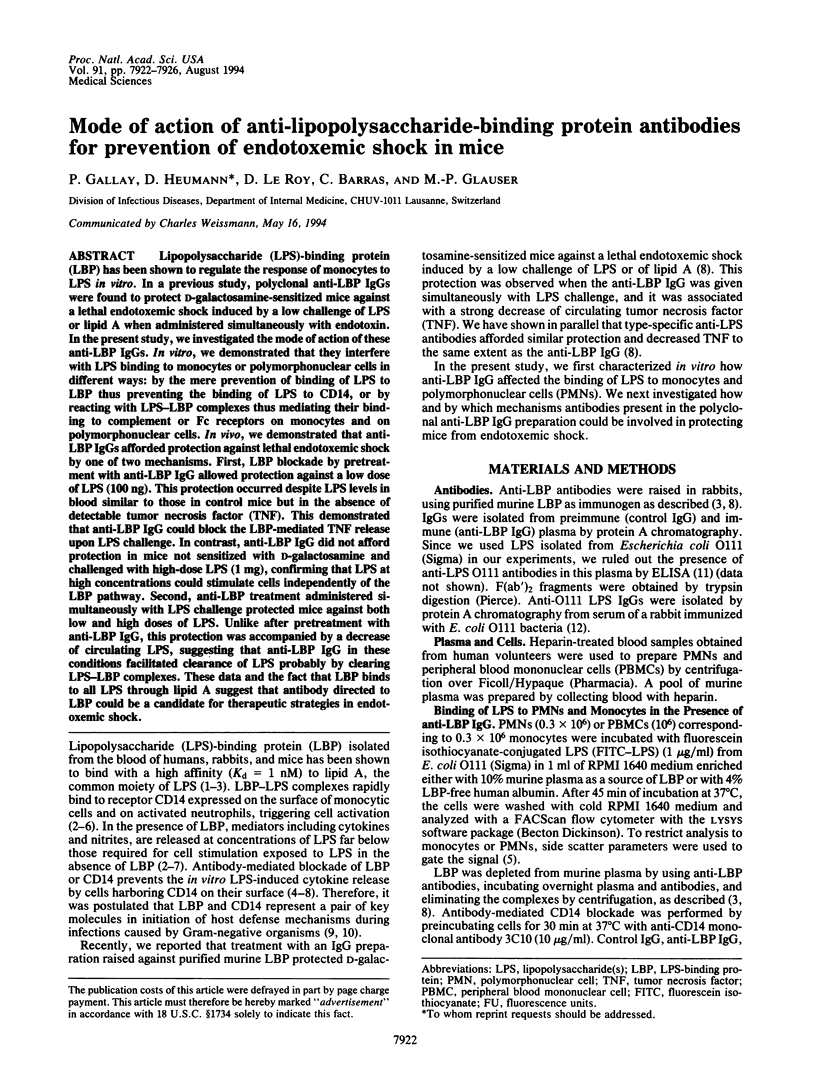
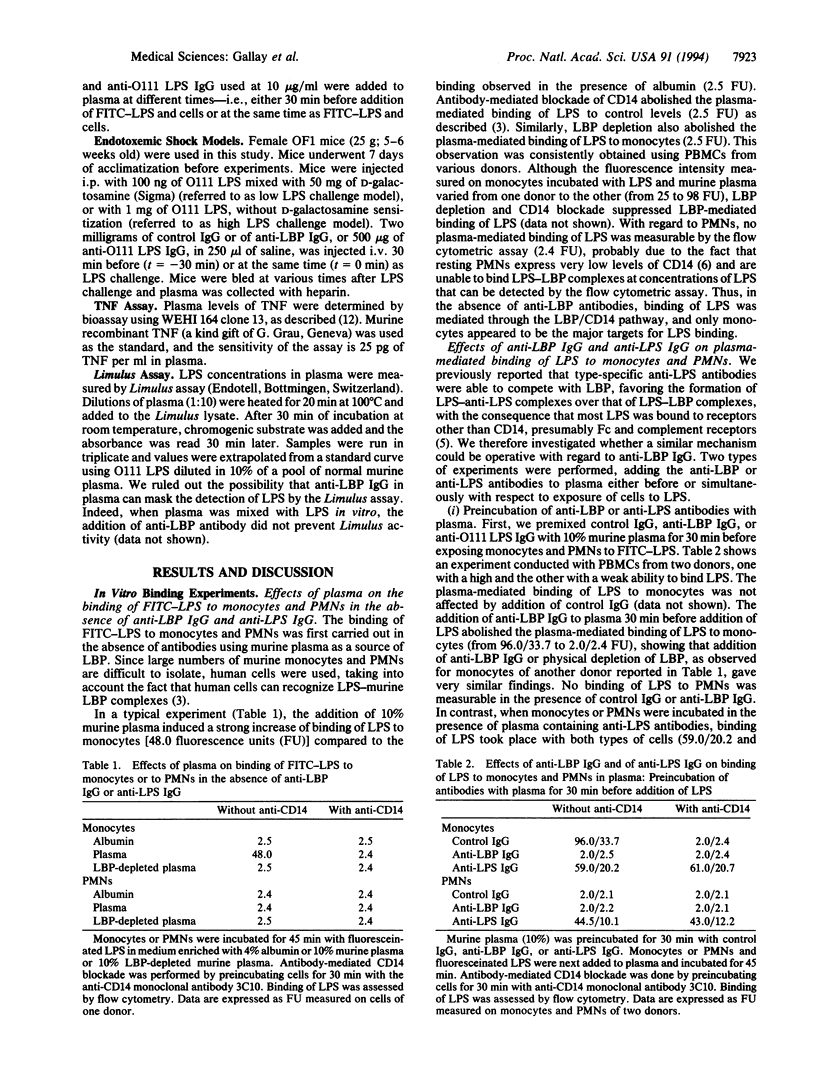
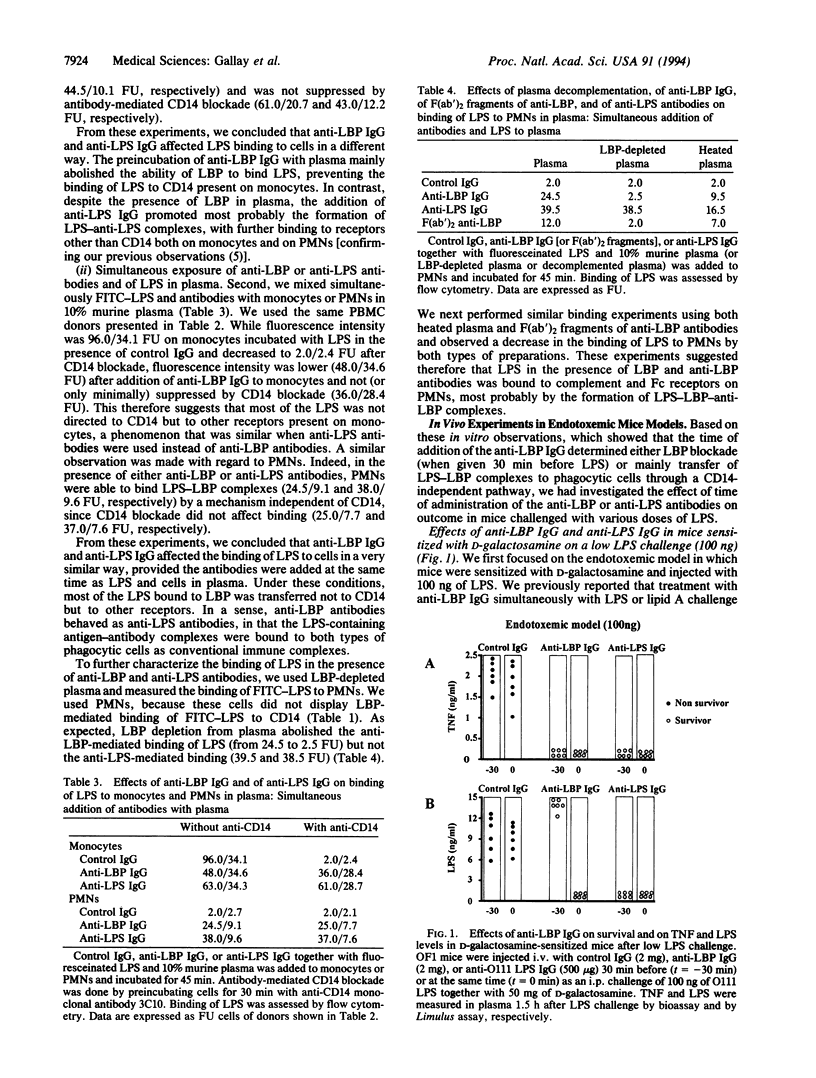
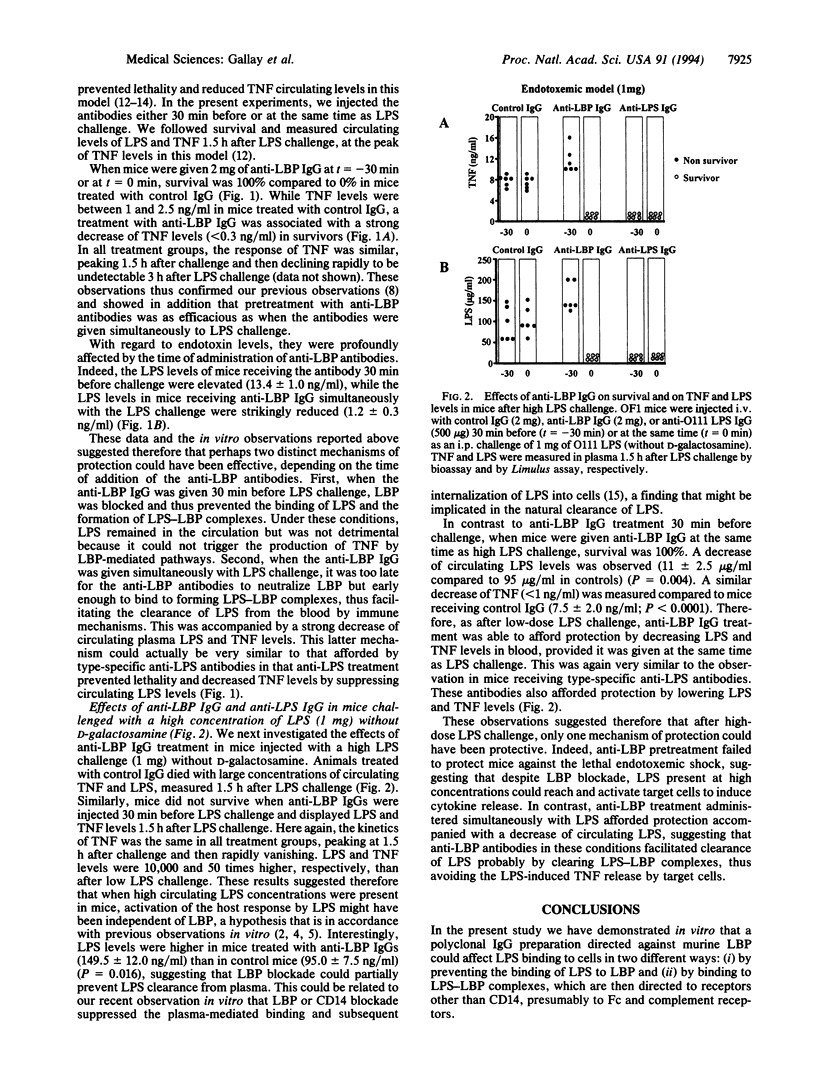
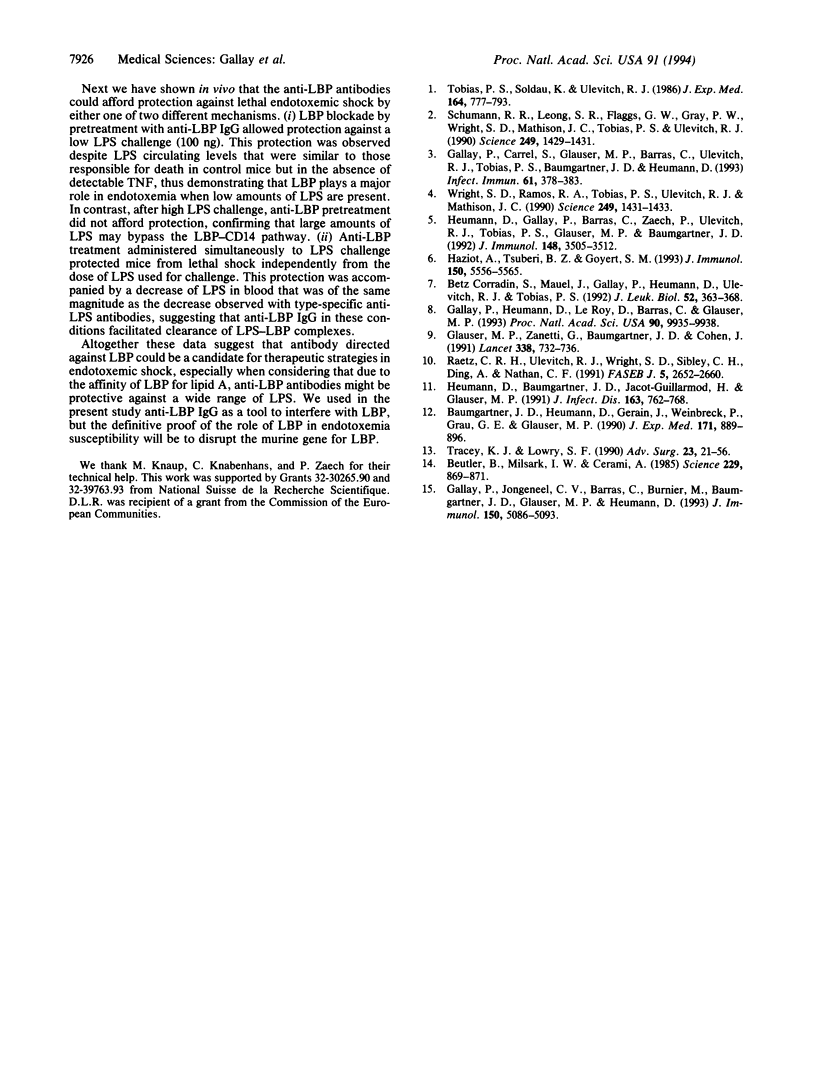
Selected References
These references are in PubMed. This may not be the complete list of references from this article.
- Baumgartner J. D., Heumann D., Gerain J., Weinbreck P., Grau G. E., Glauser M. P. Association between protective efficacy of anti-lipopolysaccharide (LPS) antibodies and suppression of LPS-induced tumor necrosis factor alpha and interleukin 6. Comparison of O side chain-specific antibodies with core LPS antibodies. J Exp Med. 1990 Mar 1;171(3):889–896. doi: 10.1084/jem.171.3.889. [DOI] [PMC free article] [PubMed] [Google Scholar]
- Beutler B., Milsark I. W., Cerami A. C. Passive immunization against cachectin/tumor necrosis factor protects mice from lethal effect of endotoxin. Science. 1985 Aug 30;229(4716):869–871. doi: 10.1126/science.3895437. [DOI] [PubMed] [Google Scholar]
- Corradin S. B., Mauël J., Gallay P., Heumann D., Ulevitch R. J., Tobias P. S. Enhancement of murine macrophage binding of and response to bacterial lipopolysaccharide (LPS) by LPS-binding protein. J Leukoc Biol. 1992 Oct;52(4):363–368. doi: 10.1002/jlb.52.4.363. [DOI] [PubMed] [Google Scholar]
- Gallay P., Carrel S., Glauser M. P., Barras C., Ulevitch R. J., Tobias P. S., Baumgartner J. D., Heumann D. Purification and characterization of murine lipopolysaccharide-binding protein. Infect Immun. 1993 Feb;61(2):378–383. doi: 10.1128/iai.61.2.378-383.1993. [DOI] [PMC free article] [PubMed] [Google Scholar]
- Gallay P., Heumann D., Le Roy D., Barras C., Glauser M. P. Lipopolysaccharide-binding protein as a major plasma protein responsible for endotoxemic shock. Proc Natl Acad Sci U S A. 1993 Nov 1;90(21):9935–9938. doi: 10.1073/pnas.90.21.9935. [DOI] [PMC free article] [PubMed] [Google Scholar]
- Gallay P., Jongeneel C. V., Barras C., Burnier M., Baumgartner J. D., Glauser M. P., Heumann D. Short time exposure to lipopolysaccharide is sufficient to activate human monocytes. J Immunol. 1993 Jun 1;150(11):5086–5093. [PubMed] [Google Scholar]
- Glauser M. P., Zanetti G., Baumgartner J. D., Cohen J. Septic shock: pathogenesis. Lancet. 1991 Sep 21;338(8769):732–736. doi: 10.1016/0140-6736(91)91452-z. [DOI] [PubMed] [Google Scholar]
- Haziot A., Tsuberi B. Z., Goyert S. M. Neutrophil CD14: biochemical properties and role in the secretion of tumor necrosis factor-alpha in response to lipopolysaccharide. J Immunol. 1993 Jun 15;150(12):5556–5565. [PubMed] [Google Scholar]
- Heumann D., Baumgartner J. D., Jacot-Guillarmod H., Glauser M. P. Antibodies to core lipopolysaccharide determinants: absence of cross-reactivity with heterologous lipopolysaccharides. J Infect Dis. 1991 Apr;163(4):762–768. doi: 10.1093/infdis/163.4.762. [DOI] [PubMed] [Google Scholar]
- Heumann D., Gallay P., Barras C., Zaech P., Ulevitch R. J., Tobias P. S., Glauser M. P., Baumgartner J. D. Control of lipopolysaccharide (LPS) binding and LPS-induced tumor necrosis factor secretion in human peripheral blood monocytes. J Immunol. 1992 Jun 1;148(11):3505–3512. [PubMed] [Google Scholar]
- Raetz C. R., Ulevitch R. J., Wright S. D., Sibley C. H., Ding A., Nathan C. F. Gram-negative endotoxin: an extraordinary lipid with profound effects on eukaryotic signal transduction. FASEB J. 1991 Sep;5(12):2652–2660. doi: 10.1096/fasebj.5.12.1916089. [DOI] [PubMed] [Google Scholar]
- Schumann R. R., Leong S. R., Flaggs G. W., Gray P. W., Wright S. D., Mathison J. C., Tobias P. S., Ulevitch R. J. Structure and function of lipopolysaccharide binding protein. Science. 1990 Sep 21;249(4975):1429–1431. doi: 10.1126/science.2402637. [DOI] [PubMed] [Google Scholar]
- Tobias P. S., Soldau K., Ulevitch R. J. Isolation of a lipopolysaccharide-binding acute phase reactant from rabbit serum. J Exp Med. 1986 Sep 1;164(3):777–793. doi: 10.1084/jem.164.3.777. [DOI] [PMC free article] [PubMed] [Google Scholar]
- Tracey K. J., Lowry S. F. The role of cytokine mediators in septic shock. Adv Surg. 1990;23:21–56. [PubMed] [Google Scholar]
- Wright S. D., Ramos R. A., Tobias P. S., Ulevitch R. J., Mathison J. C. CD14, a receptor for complexes of lipopolysaccharide (LPS) and LPS binding protein. Science. 1990 Sep 21;249(4975):1431–1433. doi: 10.1126/science.1698311. [DOI] [PubMed] [Google Scholar]


